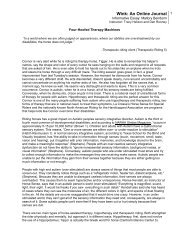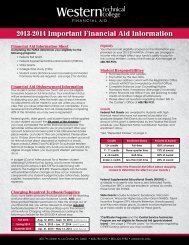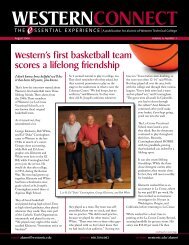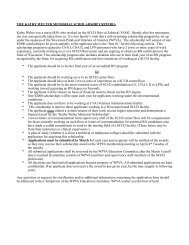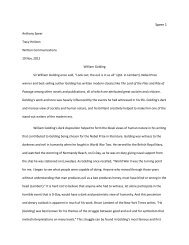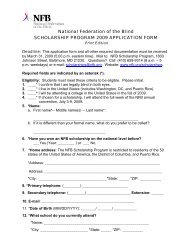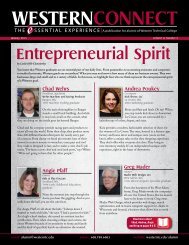The History of Western Technical College
The History of Western Technical College
The History of Western Technical College
Create successful ePaper yourself
Turn your PDF publications into a flip-book with our unique Google optimized e-Paper software.
Previous to hearing the communication, the Board adopted a ruling whereby all full-time students accepted in the<br />
school who are nonresidents must pay $10 a month tuition - up until now, the tuition fee was only for the <strong>College</strong> <strong>of</strong><br />
Commerce.<br />
On December 18, 1934, the Vocational Board met concerning the WBU issue. Attending the meeting were 17<br />
members <strong>of</strong> the La Crosse Common Council, Mr. Hambrecht, director <strong>of</strong> Vocational Education <strong>of</strong> the State <strong>of</strong><br />
Wisconsin, some students from the Wisconsin Business University, Mr. Leigh Toland, president <strong>of</strong> the WBU, and<br />
Hugh Toland, along with a few others. Leigh Toland presented a communication in person in which he stated he<br />
would mail it direct to the Board <strong>of</strong> Vocational Education. Director Hambrecht presented the history <strong>of</strong> free public<br />
school education and also the legal side <strong>of</strong> the operation <strong>of</strong> vocational schools in the field <strong>of</strong> free public education.<br />
<strong>The</strong> Vocational School Board responded to Toland's letter on May 17, 1935. <strong>The</strong> letter, signed by President Albert P.<br />
Funk, and Secretary G. M. Wiley, read:<br />
"<strong>The</strong> Board <strong>of</strong> Vocational Education <strong>of</strong> the City <strong>of</strong> La Crosse at its regular meeting under date <strong>of</strong> May 14, 1935,<br />
considered your letters <strong>of</strong> March 12 and April 18, 1935.<br />
"This Board is administering vocational education in the City <strong>of</strong> La Crosse in accordance with the laws <strong>of</strong> the<br />
State <strong>of</strong> Wisconsin governing this type <strong>of</strong> education in regard to students outside <strong>of</strong> the city. This law provides<br />
that nonresident students may attend vocational school on payment <strong>of</strong> a fee <strong>of</strong> fifty cents per day or evening <strong>of</strong><br />
actual attendance. <strong>The</strong> local Board <strong>of</strong> Vocational Education believes that is operating within the spirit and<br />
purpose <strong>of</strong> this law by admitting students to any department <strong>of</strong> the local Vocational School upon payment <strong>of</strong><br />
tuition at the rate <strong>of</strong> fifty cents per day or evening <strong>of</strong> actual attendance.<br />
"<strong>The</strong> report <strong>of</strong> the enrollment in the <strong>College</strong> <strong>of</strong> Commerce <strong>of</strong> the La Crosse Vocational School under date <strong>of</strong><br />
January 8, 1935, records 165 pupils. Of this number, 19 were nonresident students. Two <strong>of</strong> these nonresident<br />
students being included in the enrollment <strong>of</strong> students by the rehabilitation department <strong>of</strong> the State <strong>of</strong><br />
Wisconsin. <strong>The</strong> total teacher cost for all <strong>of</strong> these students is $890.00 annually. <strong>The</strong> income from tuition is<br />
$1900.00, leaving a net teacher cost <strong>of</strong> $7050.00.<br />
"<strong>The</strong> Board <strong>of</strong> Vocational Education has not broken down the capital outlay and operating costs."<br />
(<strong>The</strong> WBU, a privately operated business was founded by Frank Toland in 1892. <strong>The</strong> Toland family founded eleven<br />
business universities in six states. <strong>The</strong> local Wisconsin Business University, located at 307-309 Main Street, closed in<br />
1940.)<br />
Where the tax dollar goes - a tax mill rate increase was adopted for 1935 by the La Crosse Common Council. <strong>The</strong> 24<br />
mill rate for 1935 was based upon income and estimated expenditures <strong>of</strong> $1,633,710.34. A breakdown <strong>of</strong> a chart <strong>of</strong><br />
expenses showed that 25.4 percent was for maintaining the modern public school system and that 2.8 percent was<br />
earmarked for industrial education, the local Vocational School.<br />
On Monday, February 18, 1935, a demonstration in stencil cutting and the appropriate use <strong>of</strong> the mimeograph was<br />
given at the Vocational School. In the demonstration, a film was presented showing the processes through which<br />
stencil paper passes from the time it is a plant growing in Japan until it is used to reproduce copies <strong>of</strong> pictures or<br />
typewritten material. "<strong>The</strong>re is no country in the civilized world today that does not know the advantages and uses<br />
<strong>of</strong> the mimeograph and stencil."<br />
Friday, February 15, 1935 was the date for a Valentine Party. <strong>The</strong> social committee <strong>of</strong> the La Crosse Vocational<br />
School decided to <strong>of</strong>fer a gala party for the students and their friends. <strong>The</strong> committee chose the rhythmic and new<br />
tunes <strong>of</strong> Don Carr's orchestra. Alumni and friends <strong>of</strong> the school were invited.<br />
In response to President Franklin Roosevelt's request regarding a survey on what schools are doing for the<br />
unemployed, the La Crosse Vocational School submitted a report to the State Vocational Board indicating that<br />
• 350 high school graduates are being trained for the fields <strong>of</strong> commerce and industry,<br />
• <strong>The</strong> Vocational School has been enlarged and there were 4,492 for the first semester. In addition, there were<br />
1,202 enrolled in the EEP classes, and an additional Evening School was opened at Webster School (then located<br />
at 1402 Redfield Street in La Crosse.)<br />
• Classes/activities were conducted to take care <strong>of</strong> the leisure time <strong>of</strong> young men.<br />
• Rehabilitation - more handicapped persons are in jobs and positions, and 26 are in training.





